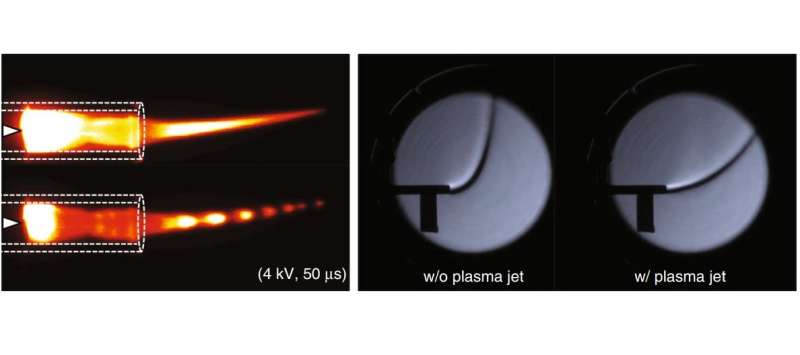(Top left) Image of the plasma jet in continuous mode and (bottom left) composite image of nanosecond-resolved images. (Right) Schlieren photography images of the trajectory of gas flow with and without a plasma jet. Credit: Park et al. Published in Nature Communications
The phenomenon of ionic wind has been known about for centuries: by applying a voltage to a pair of electrodes, electrons are stripped off nearby air molecules, and the ionized air collides with neutral air molecules as it moves from one electrode to the other. The effect is easy enough to produce that it often appears at science fairs, and may even have a future in spacecraft propulsion. However, exactly what causes ionic wind is still an open question.
In a new paper published in Nature Communications, a team of researchers from South Korea and Slovenia has experimentally investigated how ionic wind is caused when charged particles collide with neutral particles. One of their main findings is that electrons—and not only ions—play an important role in generating ionic wind, prompting them to call the effect "electric wind."
"In general, the electric wind has been called an 'ionic wind' because only the positive and negative ions have been considered as key players," coauthor Wonho Choe, Professor at the Korea Advanced Institute of Science and Technology, told Phys.org. "In our study, however, both electrons and ions participate in the generation of electric wind, depending on the polarity of the biased electrode. So the use of nomenclature for the 'ionic wind' requires a new consensus. We use the term 'electric wind' instead of 'ionic wind,' as our key finding indicates that electrons are the main player rather than negative ions such as O2- and O- during the negative voltage period."
In their experiments, the researchers generated a neutral helium flow and a pulsed plasma jet at various voltages. Then they used a technique called Schlieren photography (which is often used to photograph airplanes in flight) to take pictures of the flows of these particles. By controlling the pulse width and height of the plasma jet, the researchers monitored how these changes affect the particles' movement and the resulting wind.
As this is the first experiment to clearly show the coupling between neutral and charged particles in a plasma, the results provide direct evidence of what happens as the electrons and ions push the neutral particles away. The resulting momentum transfer causes a charged particle drag, which generates an electrohydrodynamic force (one caused by charged particles), giving rise to a clearly observable wind of charged particles.
"The electric wind was previously considered to be a result of collisional momentum transfer from accelerated charged particles and neutral particles, based on heuristic observations and experiments," Choe said. "However, as mentioned in our paper, there was no convincing evidence regarding the major mechanism (the correlation between plasma and momentum transfer) for the generation of electric wind, which is created during either the 'streamer propagation (ionization wave)' or the 'space charge drift.' Our model experiments clearly show that the contribution of the moving plasma streamer to electric wind generation is negligible, and the electric wind is mainly caused by the residual space charges after the plasma streamer propagates and collapses."
The results should lead to a better understanding of the interactions between charged and neutral particles in various situations, and has potential applications in areas such as flow control engineering.
"Our findings may have applications for reducing the drag force on a vehicle, resulting in the reduction of fuel consumption and nitrogen oxides, which are an environmental pollutant and one of the major sources of micro dusts," Choe said. "It may also reduce flow separation on wind turbine blades."
The researchers also plan to investigate potential applications with plasmas.
"One of the recent interesting topics in the plasma community is the selective control of chemical production by low-temperature air plasmas," Choe said. "We have planned research to study a correlation between plasma chemicals and electric wind. We may also investigate the possible correlation between the electric wind and the plasma ball, a phenomenon that can occur when lightning strikes."
More information: Sanghoo Park, Uros Cvelbar, Wonho Choe, and Se Youn Moon. "The creation of electric wind due to the electrohydrodynamic force." Nature Communications. DOI: 10.1038/s41467-017-02766-9
Journal information: Nature Communications
© 2018 Phys.org
























